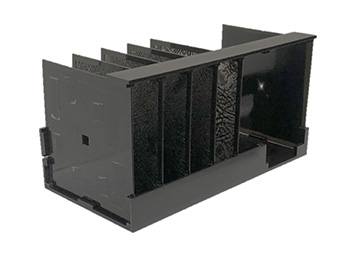![]()
Illustration of an optical diffractive network, trained with deep learning techniques, to directly shape pulses of light. [Image: Ozcan Lab, UCLA]
Direct engineering and control of terahertz pulses could boost access to those wavelengths for many powerful applications in spectroscopy, imaging, optical communications and more. But wrangling the phase and amplitude values of a continuum of frequencies in the THz band has proved challenging.
Now, researchers at University of California, Los Angeles, led by OSA Fellows Aydogan Ozcan and Mona Jarrahi, say they have used deep learning and a 3D printer to create a passive network device that can directly shape arbitrary THz input pulses into a variety of desired waveforms (Nat. Commun. doi: 10.1038/s41467-020-20268-z). The team writes that these results further motivate “the development of all-optical machine learning and information processing platforms that can better harness the 4D spatiotemporal information carried by light.”
Shaping any terahertz pulse
The team’s method, Ozcan says, can directly shape any input THz pulse through passive light diffraction via deep-learning-designed, 3D-printed polymer wafers. It is fundamentally different, he says, from previous approaches that indirectly synthesize a desired THz pulse through optical-to-terahertz converters or shaping of the optical pump that interacts with THz sources.
What is more, Ozcan adds, the deep-learning framework is flexible and versatile; it can be used to engineer THz pulses regardless of polarization state, beam shape, beam quality or aberrations of the specific generation mechanism.
Diffractive optical networks
In 2018, Ozcan’s group reported development of the first all-optical diffractive deep neural network using 3D-printed polymer wafers with uneven surfaces for light diffraction. That work was primarily about machine learning by way of light propagated through the trained diffractive layers to execute an image-classification task, he says.
But deep-learning-designed diffractive networks can also tackle inverse design problems in optics and photonics, Ozcan says, and the team’s new work in THz pulse shaping “highlights this unique opportunity.” They used diffractive optical networks—four wafers in a precisely stacked and spaced arrangement—to shape pulses by simultaneously controlling the relative phase and amplitude of each spectral component across a continuous and wide range of frequencies, the researchers write.
On-demand synthesis of new pulses

A 3D-printed optical diffractive network that is used to engineer THz pulses. [Image: Ozcan Lab, UCLA]
For on-demand synthesis of new pulses, Ozcan says, the team used a Lego-like physical transfer learning approach. That is, by training with deep learning a new layer or layers to replace part of an existing network model, the team found new pulses can be synthesized.
In terms of its footprint, the pulse-shaping framework has a compact design, with an axial length of approximately 250 wavelengths, Ozcan says. Moreover, he adds, it does not use any conventional optical components such as spatial light modulators, which makes it ideal for pulse shaping in the THz band—where high-resolution spatiotemporal modulation and control of complex wavefronts over a broad bandwidth represent a significant challenge.
Improving efficiency
To improve the efficiency of the network, Ozcan says, a switch to low-absorption polymers for the 3D-printing material could be beneficial. To further improve output efficiency, he says, antireflective coatings over diffractive surfaces could be used to reduce back reflections.
Altogether, the capabilities of the deep-learning-designed diffractive network approach to pulse shaping enable a variety of new opportunities, Ozcan says. When merged with appropriate fabrication methods and materials, he adds, the approach can be used to directly engineer THz pulses generated through quantum cascade lasers, solid-state circuits and particle accelerators.
“There is already commercial interest in licensing diffractive-network–related intellectual property,” Ozcan says, “and we expect this to accelerate as we continue demonstrating some of the unique advantages of this framework for various applications in machine learning, computer vision and optical design.”
The team is also working on visible diffractive networks, which could benefit various applications in computer vision and computational imaging fields, says Ozcan, calling it “work in progress.”
